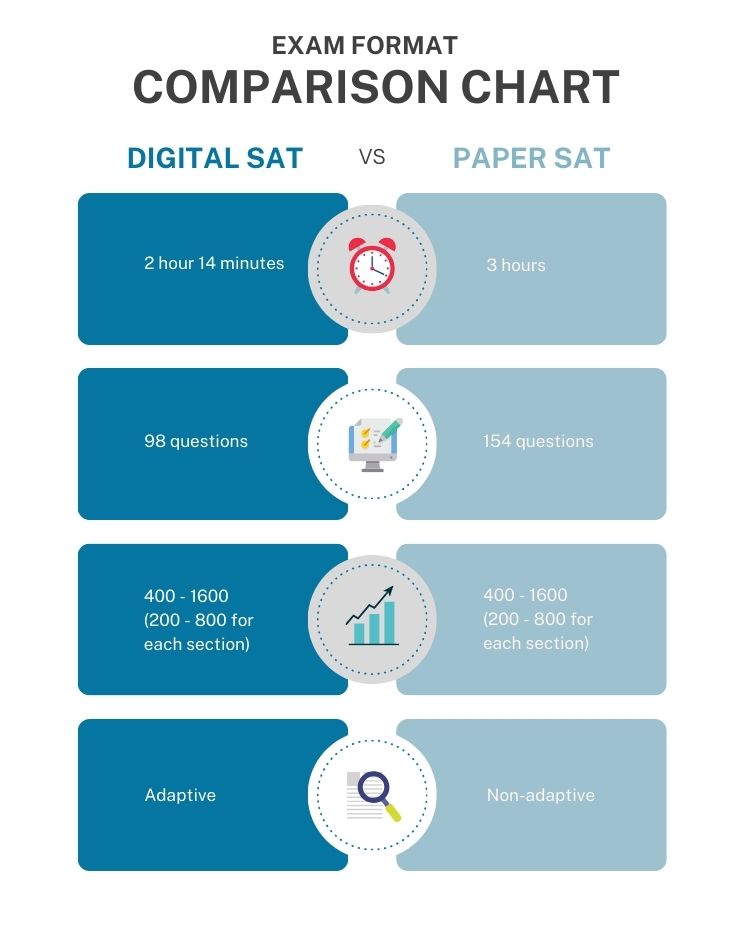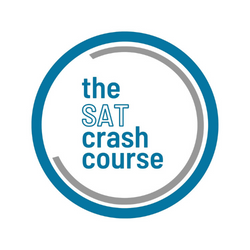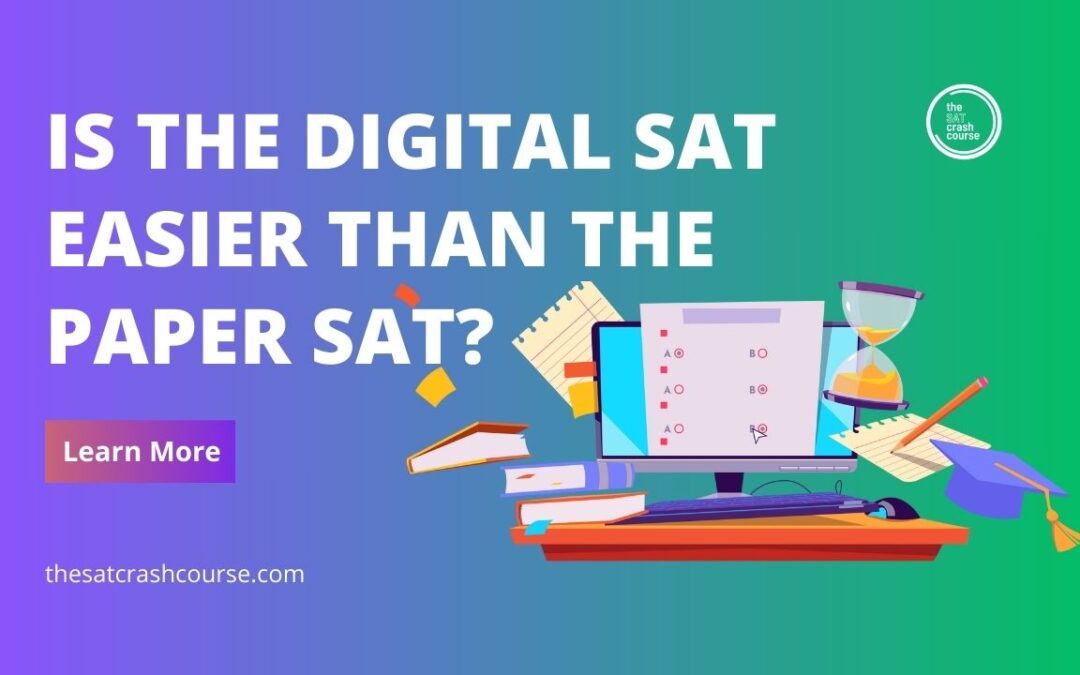As the SAT has officially gone fully digital in the United States since March 2024, students have many questions regarding the changes in the new SAT. Among those, the most frequently asked one is “Is the digital SAT easier than the paper and pencil SAT?”. It is natural that students ask this question because the answer will affect their test prep planning amongst other college prep agendas.
It will be nice to have a yes and no answer, but the answer may depend on individual students’ academic traits and preferences. However, we can look into factors in the digital SAT that may be relevant to decide if the test is easier or harder in your own case. So from now, let’s dive into the digital SAT facts one by one and determine how the level of difficulty has changed with the new aspects.
The Format of the Digital SAT
There have been major changes in the SAT not only in technical terms but also in the structural terms. Before we look into the digitalized testing method, let’s review the renewed format of the test and how the change affects students’ sense of its difficulty.
The Shortened Length & Reduced Number of Questions
First of all, the digital SAT is significantly shorter than the paper SAT with only 2 hours and 14 minutes of duration. This is almost an hour shorter than the paper SAT, which was 3 hours total in length.
Also, the number of questions has also reduced to a total of 98 questions in the new SAT from 154 questions in the paper SAT. This lighter nature of the digital SAT may relieve the test-taking pressure for many students.
Students also have more time to solve questions in the math section. The section has a increased time allotment of 1 minute 35 seconds per question compared to 1 minute 15 seconds and 1 minute 27 seconds in the no calculator and calculator section respectively in the paper SAT. In the Reading and Writing section, students have 1 minute 11 seconds per question whereas they used to have 1 minute and 15 seconds in the Reading section and than 48 seconds in Writing section.
Adaptive Testing and Modules
Another significant change in the new SAT is that the digital SAT uses adaptive testing. It is a system in which the test “adapts” to the student’s performance, therefore providing more relevant questions to assess their academic level. This is realized in the digital SAT with the use of modules. In each section, there are two modules for students to complete. Based on how the student did on the first module, the test decides to give either the harder or easier second module.
Whereas the first module is a mix of all levels of questions, the second module will consist more of either easier or harder questions based on which module the student gets. This makes the level of difficulty in each student’s test different from others.

What Can Make the Digital SAT Seem Easier
Before we look into this topic, it’s worth noting that the College Board has stated that the digital SAT aims to maintain its level of rigor in assessing a student’s skills and knowledge. However, the standardized test organization has also mentioned that the digital SAT is aims to make student’s test-taking experience less stressful. There are a few evidences in the new SAT that aligns with this statement. These factors listed below may make the test more approachable for students.
Reading Passages are Shorter
The passages in the Reading and Writing section have been shortened, which would help test takers make the most use of their concentration span. The passages will be less than 150 words in the new SAT, compared to several hundred words in the past. In addition, there will be only one question tied to each passage instead of multiple questions. Students will no longer have to go back and forth between questions, which further facilitating students’ problem solving pace.
Calculator is Allowed for the Entire Math Section
The math section is no longer divided into no-calculator and calculator section, but allows the use of calculator for the entire section. This can be beneficial to students who are trained to use it proficiently in adequate situations.
Less Wordy Math Problems
In-context questions in the Math section, as known as word problems, became less wordy and more concise. This will help students focus solely on utilizing their mathematical thinking by reducing their burden on processing text information.
What May Make the Digital SAT Seem Harder
Despite some student-friendly features mentioned above, there are a few aspects of the digital SAT that may make it seem challenging. Below are the factors.
Adaptive Modules
As mentioned above, the adaptive nature of the digital SAT may bring different test-taking experience for students. This is to say advanced students may get harder second module because they performed well on their first module.
This sounds unfair at first. However, this is not bad for them at all because the more hard questions they get right, the higher their scores will be. In other words, students have more potential for to be in the top percentage when they receive a harder module. This is because the weight of the questions vary according to their difficulty level. Even if a student gets all the questions in the easier second module, there is a limit to the score that the student can achieve.
Adaptive testing is the point when the digital SAT becomes personalized in terms of its difficulty. But whether the test feels easy or hard, you will get a score that shows your abilities if you do your best in it.
Digitalized Testing Method
As the name presents, the digital SAT is administerd through a digital medium, requiring students to take the test on an electronic device. The College Board provides an app called Bluebook for students to use while taking the test.
The problem with digitalized testing environment is that it may require some time for students to get used to. Students will need to solve the questions on-screen, which may feel different from solving them on a piece of paper.
To better acclimate themselves to this digitalized testing, students may need to familiarize themselves with the tools in the testing app. Annotation tool, calculator, “mark for review’ tools are made to aid students’ test-taking. Students may benefit from taking digital SAT practice tests to acquire the skills to use the tools.

So Is the Digital SAT Easier?
Given all the factors above, are we ready to decide if the digital SAT is easier? While you may already have your own answer, let’s go back to the factors introduced in this article that may affect the level of difficulty in your case.
- The digital SAT is shorter
- The digital SAT uses adaptive testing, which may alter the level of difficulty for each student
- There are aspects in the new SAT that make the test “student-friendly”
- The digitalized test-taking may require some time to get used to
Reviewing these facts, it’s possible to say that students may feel the digital SAT easier than the paper SAT. This is largely due to the fact that the aspects of the new SAT may lighten the load for many test takers. These changes made in the new SAT may increase student’s focus and efficiency in problem-solving, therefore making the test-taking experience more manageable for students.
However, it’s worthwhile to keep in mind that personal preference in test-taking may also affect students’ comfort level. As the new SAT is administered in a digitalized settings, students may need to learn how to convert their traditional test-taking skills to those suite in online realm.
Conclusion
Comparing both versions of the SAT, there are several factors that indicate the possible advantages that the digital SAT provides over the paper SAT. The updated features in the new SAT may lighten students test-taking pressure and help them perform their potential.
That being said, it will be in students’ best interest to familiarize themselves with the new testing environment to enjoy the benefit this new test presents. After all, students will be able to better concentrate on the test content when they are comfortable with the specifics of the new exam. To return to the big question of this article, the digital SAT can feel easier for students who knows their way around it!
Start Studying with Us!
Ready to start preparing for the Digital SAT? Start with our free mini DSAT test!

